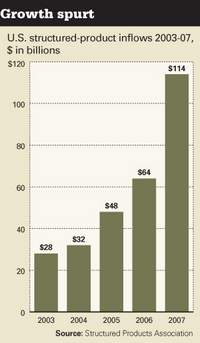By: Akhilesh Singh
Over the years, investment managers have worked hard to develop products that suit various investor profiles. Asset managers in western countries have been offering products across asset classes such as equities, debt, foreign exchange, commodities , and so on, for a long time now. However, in India, the pace has been comparatively slow in innovating and offering such products, partly due to regulatory issues and partly due to the lack of investor awareness and acceptance.
In the last three years, there has been a significant effort by the investment managers to offer equity-linked derivatives structures in India, and many of the most sophisticated equity derivatives structured products have been introduced recently. They have developed significantly, largely due to constantly changing market dynamics, and therefore the changing investor appetite, which has encouraged the investment managers to innovate and modify constantly.
What they are
They are an effective and efficient way to invest in hybrid structures that allow one to invest in debt while also participating in equity markets, without risking one’s capital, and, in certain cases, even guaranteeing at least a minimum return.
Most structures in India offer 100% capital protection. However, if you’d like a more aggressive structure, capital protection may be a little less than 100%, depending on product design. As such, they are mainly used within the secure part of a portfolio to increase returns with limited risk on capital. Equity derivative structured products can also be customised to meet an investor’s risk or return profile.
Advantages
For one thing, they provide an opportunity to participate in equity markets coupled with capital protection or even return protection. This kind of product is best suited for investors who are very conservative , but who also want to enhance returns without taking any additional risk.
Secondly, equity derivative structured products enable risk-controlled access to volatile asset classes and alternative investments. In the current market scenario, these kinds of products offer a fantastic risk-minimised investment option in alternate asset classes.
Thirdly, they are an efficient diversification tool. They help diversify the portfolio management style, and hence provide a hedge in the portfolio in case of a difficult market situation.
Fourthly, they offer an efficient way for an investor to take advantage of a given market scenario. Fund managers have been constantly churning various structures that suit the prevailing market and economic situations, which helps the investor to adjust to the changed scenario and accordingly make her or his investment decisions.
And fifthly, equity derivative structured products let us minimise the frequency of interventions , which are too often guided by sentiment. These products are closed-ended and mostly follow a predefined investment strategy that is executed in the beginning. One cannot make any changes later in the structure. However, this can, in some situations, be detrimental to performance.
Types of products
There are several types of equity derivative structured products. Investors can choose from the palette depending on their risk profile.
High fixed return products:
These compare with debt products, and offer a high yield on the portfolio and keep a measured equity participation, to ensure low-to-moderate risk. Investing in such products also helps the investor get a higher post-tax yield, as these debentures attract long-term capital gains tax for such structures that mature over a 365-day period , where the tax rate is lower than on fixed deposits.
Market neutral products:
These are designed for investors who don’t have directional market views, and especially suited for highly volatile and uncertain market environments. These products are designed to yield betterthan-market returns if the markets rise, but—pleasantly enough—give similar returns even when the markets move downwards. Investors who have been historically investing in bank fixed deposits because of a strong aversion to risk should consider such product structures.
High equity participation:
These products offer a high level of equity participation. However, they still hedge or limit the downside risk on the capital. These structures are ideal for investors who are aggressive and want significant participation in a rising market , and are willing to sacrifice their fixed-income returns for that opportunity. However, these structures mostly do not allow positive participation if the markets are bearish. In my assessment, these products offer investors the best of both worlds, with riskadjusted returns. When the markets are volatile and directionless , they hedge or at least limit the downside risk, and eliminate the need to monitor one’s portfolio daily. They also eliminate the risk of impulsive decisions.
Akhilesh Singh is Business Head, Emkay Midas Wealth Management
Wednesday, July 23, 2008
Subscribe to:
Comments (Atom)



